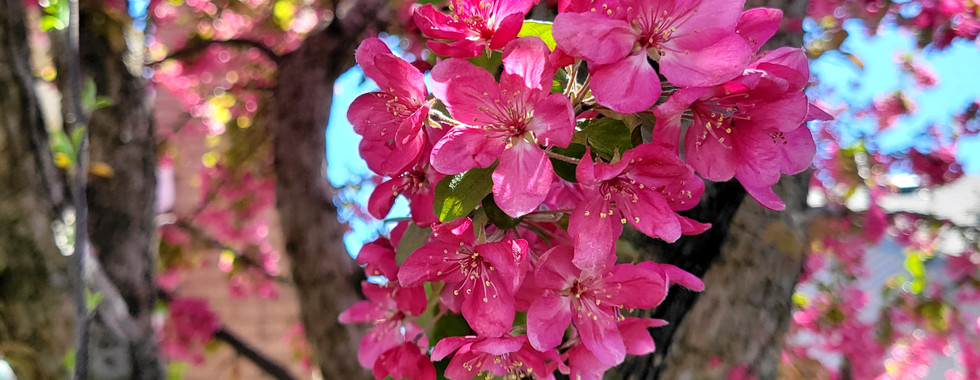Ornamental Crabapple Trees
- Owner: Holly Dz

- Apr 1
- 5 min read
Corresponding Blog for Podcast Episode 109
Ornamental Crabapples have the most vibrant spring colors ranging from shades of pink, red, purple, and white with showy red or yellow fruit. It may not be the first blooming tree of the season but it is a sure sign spring is here with summer right around the corner!
Apart of the Rose family- Rosaceae
Also includes cherries, plums, roses, cotoneaster, potentilla, ninebark, geum, etc
Genus: Malus
Crabapples have a wide range of growth habits and sizes making it a versatile tree to plant in your landscape. These trees bloom between May and June with the crabapples forming on most trees between July and November depending on the variety.
The hardiness zone is dependent on the variety but it is generally within zone 3-7.
White Blooming Crabapples:
*Sargent Tina: Petite low growing tree reaching about 5' tall and 6' wide, white flowers, green foliage, and red fruit
*Firebird®: Compact growth growing 8' tall and 10' wide, white flowers, green foliage, and red fruit
*Sargent: Compact growth growing 8' tall and 12' wide, white flowers, dark green foliage, and red persistent fruit
*Lollipop®: Round growth growing about 10' tall and wide, white flowers, green foliage, and yellow fruit
Red Jewel™: Upright growth reaching about 15' tall and 12' wide with white flowers, green foliage, and bright red persistent fruit
Sugar Tyme®: Round growth growing about 18' tall and 15' wide, white flowers, green foliage, and red persistent fruit
*Adirondack: Upright growth reaching about 18' tall and 10' wide with white flowers, green foliage, and bright red fruit
Golden Raindrops®: Upright growth reaching about 20' tall and 15' wide with white flowers, green deeply cut foliage, and yellow fruit
Snowdrift: Round growth growing about 20' tall and wide, white flowers, green foliage, and red/orange persistent fruit
Donald Wyman: Round growth growing about 20' tall and 25' wide, white flowers, green foliage, and red persistent fruit
Spring Snow: Round growth with white flowers, green foliage, no fruit, growing about 25' tall and wide
Pink/Red/Purple Blooming Crabapples:
Louisa: Weeping growth reaching about 10' tall and 12' wide with pink flowers, dark green foliage, and yellow fruit
*Coralburst®: Round growth reaching about 15' tall and wide with double pink flowers, dark green foliage, and yellow fruit
Red Barron: Upright growth reaching about 18' tall and 8' wide with dark pink flowers, dark purple foliage, and red fruit
*Gladiator™: Upright growth with purple/pink flowers, dark purple foliage, red fruit, growing about 20' tall and 10' wide
Royal Raindrops®: Upright growth reaching about 20' tall and 15' wide with bright pink flowers, purple foliage, and red persistent fruit
Purple Prince: Round growth growing about 20' tall and wide, dark pink/red flowers, purple foliage, and dark red fruit
Adams: Round growth growing about 20' tall and wide, dark pink flowers, green foliage with slightly purple tint in spring, and red persistent fruit
Prairiefire: Round growth growing about 20' tall and wide, dark pink flowers, purple foliage, and dark red fruit
* Varieties that are resistant to diseases and pests
Sun Requirements:
Crabapples should be placed in full sun to help with the best blooms and fullest foliage. It is also best for disease prevention since usually a full sun location has decent air circulation.
Water Requirements:
Since this plant is hardy and reliable, they follow the typical tree watering instructions! They like average moisture but can be drought tolerance once established.
It is best to water heavier and less frequently than less water and more often.
For the first full season, you will need to keep up with watering. Plants in the first establishing year need 2 inches of water a week. This could be provided by rainfall but if it isn't, a deep soak around out once every 5-7 days in enough water.
In the second and third year, you may need to provide supplemented water if there is a drought but they shouldn't need much more help.
Diseases Information:
The major concern with crabapples is the susceptibility to diseases. Frankly, this is a common problem and I would highly recommend you research the varieties you want a bit more before diving in.
Apple Scab: causes defoliation in summer
Fire blight: leaves and flowers may turn brown or black and droop
Cedar- Apple Rust: you will most commonly see rusty, orange spots on the leaves
Other Facts:
Native to North America, Europe, and Asia
Avoid high nitrogen fertilizer as this can increase the chance of disease
Suckers will form at the base of most Crabapples so it is best to remove those to allow the plant to focus on the main branches.
Prefers heavy-loam soil but can tolerate clay soils if they are well-draining with no standing water
For more Landscape information, check out the following podcasts and blog
Instagram Q&A:
I always ask followers if they had any specific questions, opinions or hot-takes I can address in this podcast and blog. Here are what people told me and and my answers for this topic:
"Are crabapples poisonous for dogs?"
YES these are toxic to pets so please be careful if you have a pet that likes to munch on your plants outside.
"Why are they called crabapples?? Why don't they produce apples?"
The branches tend to be irregular, spiny, gnarled looking which could be called a "crabbed" appearance. They do produce crabapples which, according to Iowa State University, are not poisonous to humans. They can be eaten but usually aren't worth it since they are bitter. But don't worry, the birds and other wildlife would love to have the option of this fruit if you leave it for them!
"Do you have a fave? Any in your yard?"
I love the upright growers, Adirondack or Red Barron since they have a unique shape. I also always loved the Coralburst because of the flower color and uniform shape. There are none in our yard and I probably would put one in my yard because I don't want a chance of introducing diseases to my landscape.

WANT TO LISTEN?
Go to Apple Podcasts, Spotify, Stitcher, Google Podcasts, and more! Search for Houseplant Homebody to hear this episode and MANY more! You can also listen directly on my website under the Podcast page!
DON'T FORGET TO FOLLOW!
Stay connected on Instagram, Facebook, and Pinterest @houseplanthomebodyllc.
SAVE, COMMENT, LIKE, FOLLOW, SUBSCRIBE, and SHARE.
All your engagement on my podcasts, blogs, and social media posts help other plant lovers find me too!
Always written with extreme plant passion!
Love, Holly (Owner & Creator of Houseplant Homebody LLC)





























Comments